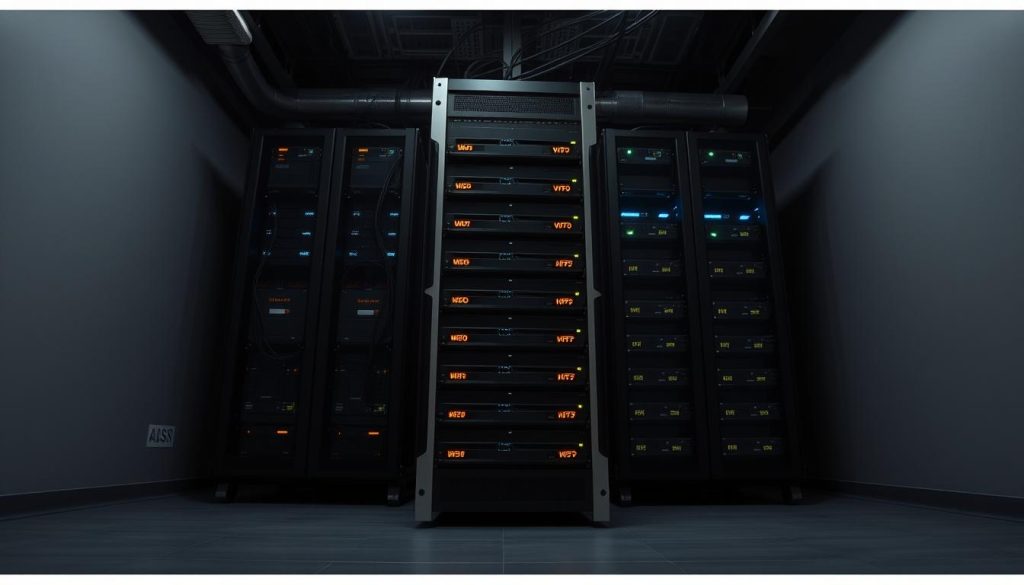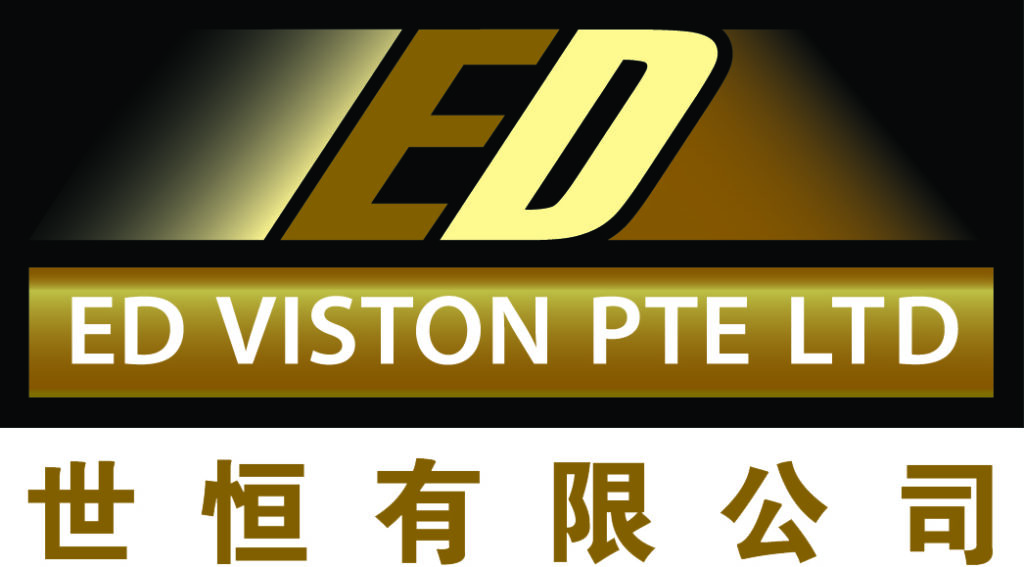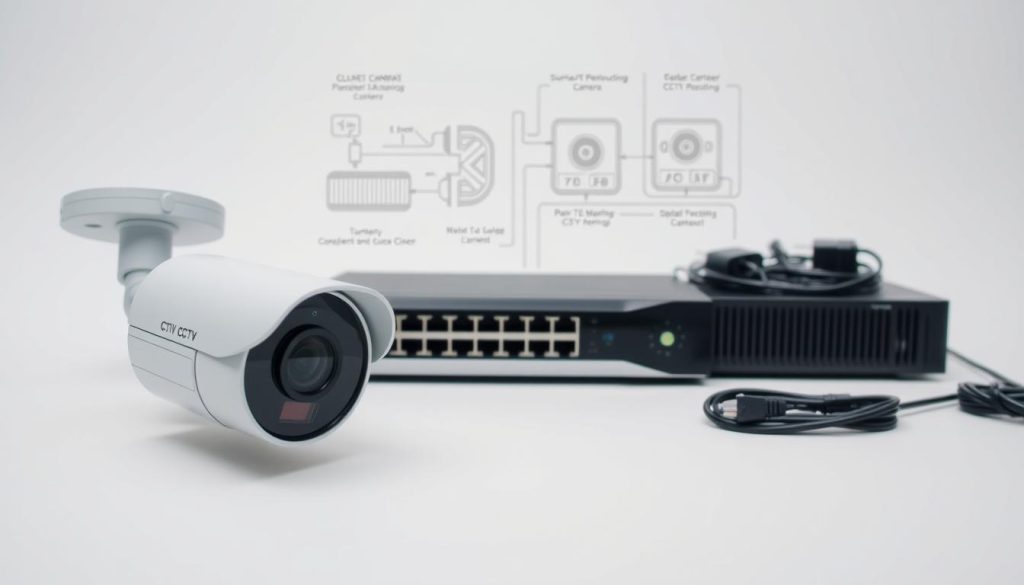Security concerns are on the rise in many areas, making CCTV systems more important than ever. In Singapore, these systems are key to boosting safety by watching and recording what happens. They help prevent crime by being a visible presence.
Knowing the main parts of CCTV systems is key to making them work better. The seven main parts are security cameras, monitoring stations, video recording systems, and accessories. There’s also storage solutions, power supply, and video management software. Each part helps create a strong security system that keeps users safe.
Key Takeaways
- CCTV systems are integral to enhance security in various environments.
- There are seven main components that make up an effective CCTV system.
- Security cameras are critical in monitoring and recording activities.
- The technology plays a significant role in deterring crime.
- Understanding each component helps optimize surveillance efforts.
Introduction to CCTV Technology
CCTV technology is key in boosting security in many fields. As we all know, fighting crime is more important than ever. This is why CCTV systems are in high demand. They watch over activities and help prevent crimes.
The Importance of CCTV in Security
CCTV cameras make places safer, both public and private. They scare off criminals, making it less likely for bad things to happen. Plus, when crimes do occur, the footage is a big help for police and courts.
Common Applications of CCTV Systems
CCTV systems are used in many places, showing how they can keep us safe. Here are some examples:
- Retail places use them to stop theft and keep customers safe.
- Schools watch over campus life to protect students.
- In public areas like parks and streets, they help police keep things orderly.
- Industrial sites use cameras to guard important areas and check how things are running.
Understanding the Role of CCTV in Surveillance
CCTV systems are key to making cities safer, like Singapore. They help keep an eye on public spaces, making surveillance better. This means safer streets for everyone.
How CCTV Enhances Security in Singapore
CCTV has changed how Singapore keeps its streets safe. Cameras in busy spots like malls and transport hubs help the police watch over the city. This makes people feel safer and helps stop crimes before they start.
Impact of CCTV on Crime Prevention
Studies show CCTV helps lower crime rates. In Singapore, places with cameras see less crime. This is because cameras make it easier for police to act fast and scare off criminals.
What are the 7 components of CCTV?
Knowing about CCTV components is key to making a good surveillance system. These parts work together to give the best security. They are:
- Security Cameras – These are the most visible parts, recording video as it happens.
- Monitoring Stations – Here, people can watch and control the camera feeds.
- Video Recording Systems – These are needed to save the video for later use.
- Supporting Accessories – Tools like brackets and enclosures help the system work better and easier to install.
- Storage Solutions – Important for keeping video data safe and easy to find, often using hard drives or cloud storage.
- Power Supply – Makes sure all parts get the power they need to work right.
- Video Management Software – This is key for managing the CCTV parts, giving a single view of all surveillance data.
Each surveillance system part is vital for a complete security solution. Knowing how they work helps make a system that fits your needs.
Security Cameras: The Heart of CCTV Systems
Security cameras are key to any CCTV system, giving us the visuals we need to watch and keep an eye on things. Choosing the right cameras is important for a good surveillance setup. It’s key to know the difference between analog and IP cameras.
Types of Security Cameras: Analog vs. IP
Analog cameras have been around for a long time. They’re simple and reliable. They’re easy to set up, which is great for many people.
IP cameras, on the other hand, use internet technology. They offer better quality and can be set up in many ways. They also let you access them from anywhere and work with other smart devices.
Camera Configurations: Bullet, Dome, and PTZ
Choosing the right camera setup is important for good surveillance. There are different types of cameras for different needs:
- Bullet Cameras: These are easy to see and work well outside. They’re shaped for long-distance viewing.
- Dome Cameras: These are not as noticeable and work well inside and outside. They’re hard to tamper with, making them good for stores.
- PTZ Cameras: These cameras can move and zoom, covering big areas. They’re flexible for changing environments.
It’s important to know the good and bad of different security cameras and setups. This helps make better choices for security.
Monitoring Stations: Where Surveillance Takes Place
Monitoring stations are key to any good CCTV system. They let operators watch many camera feeds at once. To make a good monitoring station, you need to think about layout, technology, and what the operators need.
Setting Up Effective Monitoring Stations
Here are some important things to consider when setting up monitoring stations:
- Comfortable Work Environment: Operators need ergonomic workstations to stay focused during long hours.
- Strategic Camera Placement: A good layout helps see everything clearly and avoids blind spots.
- Technology Integration: Using high-resolution screens and good software makes monitoring better.
- Remote Access Capabilities: Make sure operators can watch feeds from anywhere to be more flexible.
Features of Modern Monitoring Stations
Modern monitoring stations use new tech to make surveillance better. Some key features are:
- Advanced Software Applications: These help analyze and alert for any odd activity in real-time.
- Mobile Access: Operators can watch feeds on their phones, making them more responsive.
- Multi-Screen Setups: Having many screens lets operators watch lots of feeds at once, keeping them alert.
- Data Management Tools: Good storage solutions help keep and find recorded footage easily.
Video Recording Systems: Capturing Footage
The success of CCTV systems relies heavily on their video recording systems. These are key for processing and storing footage. There are two main types: Digital Video Recorders (DVR) and Network Video Recorders (NVR). Each has special features for different surveillance needs.
DVRs work with analog cameras and change video signals to digital. This makes storing footage easier and familiar for users. NVRs, on the other hand, are for IP cameras. They offer better quality and flexibility in managing video.
More people are choosing NVRs as IP systems become more common. They work well with advanced technology and are easy to use. Video recording systems also connect with workstations for organizing and managing footage.
Both DVR and NVR setups can offer strong solutions for storing footage. Knowing the differences helps users choose the best for their CCTV systems. This ensures they get the most out of their installations.
Supporting Accessories for CCTV Systems
For CCTV systems to work well, you need the right accessories. These include camera cables, routers, and connectors. Each one is key for a strong connection and better system performance.
Essential Cables for Connectivity
Camera cables connect cameras to recording devices. High-quality RG59 Siamese coaxial cables ensure a steady connection. They carry both video and power, making setup easier.
Using the right cables is vital for a good CCTV system. They keep your system running smoothly.
Importance of Routers and Connectors
Routers are essential for wireless CCTV systems. They help cameras and monitoring stations talk to each other. When picking a router, think about your budget, ISP compatibility, and coverage.
Choosing the right router boosts your system’s performance. Connectors are also critical. They help different parts work together, creating a strong connection between cables, cameras, and devices.
Storage Solutions: Keeping Video Data Safe
Effective CCTV systems need good video data storage solutions. This ensures vital footage stays safe and easy to access. The right storage devices are key to keeping data safe.
High-performance storage, like surveillance-grade hard drives, is vital. They handle the big amounts of video data CCTV systems make.
The Need for High-Performance Storage Devices
Surveillance needs strong and reliable storage. Standard hard drives can’t handle CCTV’s constant recording and playback. High-performance devices ensure fast access and durability for constant surveillance.
This means critical incidents are recorded well. And they can be easily found during investigations.
Data Protection Strategies for Footage
Protecting video footage is essential. Using RAID systems for backup is a good start. They help in case of hardware failure.
Cloud backups add another layer of security. They store footage off-site, reducing damage risks. Encryption also keeps data safe from unauthorized access, meeting privacy rules.
These strategies together create a strong data protection plan. They make CCTV storage solutions more reliable and secure.

Power Supply: Ensuring System Functionality
The reliability of a CCTV system depends a lot on its power supply. It’s important to organize CCTV power supply solutions well. This ensures the system works at its best. You can choose from individual transformers or integrated power supply boxes for multiple cameras.
It’s key to know the difference between AC and DC power. AC is good for long distances, but DC is better for cameras. DC power is more stable and performs better. Each power type plays a special role in how well the surveillance system works.
Having enough power supply helps avoid early equipment failure and keeps things running smoothly. A well-organized power setup improves camera stability and performance. This leads to better surveillance results.
Video Management Software: Managing Your CCTV System
Video management software (VMS) is key for good CCTV system management. It has features to boost surveillance, making it simpler to watch video from many cameras. With integrated VMS, managing video data gets easier and more efficient.
Features of Integrated VMS
An integrated VMS has important features that improve CCTV systems. These include:
- Centralized video storage for easy access and management of recorded footage.
- Advanced analytics tools to spot unusual activities or patterns.
- Unified interfaces for managing many camera feeds from one dashboard.
Benefits of Using Video Management Software
Using video management software in your CCTV system has many benefits. Some key advantages are:
- It makes operations more efficient, leading to faster responses to incidents.
- It helps meet surveillance and data protection standards.
- It simplifies surveillance management, making it easier to keep and use the CCTV system.
Video management software boosts security and improves system function. It’s a vital tool in today’s surveillance strategies.
Maintaining Your CCTV System for Optimal Performance
Keeping your CCTV system in top shape is key for its best performance. Regular care stops sudden breakdowns and makes your gear last longer. It’s important to stick to a plan for CCTV upkeep. This includes regular checks and updates to keep your system running smoothly.
Regular Maintenance Tasks
Doing regular maintenance is vital for your CCTV system’s success. Make sure to include these tasks in your routine:
- Check Camera Positioning: Make sure cameras are set up right and focused on important spots.
- Inspect Cables: Look for any damage on cables that could cause problems with connections.
- Clean Camera Lenses: Dirty lenses can mess up image quality. Cleaning them regularly helps keep things clear.
- Review Storage Solutions: Check that your video storage is working well and has enough room.
Importance of Software Updates
Keeping your CCTV system’s software current is a big part of good maintenance. Regular updates are important for several reasons:
- Enhance System Performance: Updates often make your system work better.
- Address Security Vulnerabilities: Many updates fix security issues, making your system safer.
- Introduce New Features: Updates can add new features or improvements to your surveillance.
The Future of CCTV Technology
The future of CCTV technology is changing fast. New technologies like artificial intelligence (AI) will make cameras smarter. They can spot threats and oddities right away. This means security teams can act quicker, making cities like Singapore safer.
Cloud-based storage is also becoming a big deal. It lets us store lots of video data easily. This makes sure our footage is safe and easy to get to on different devices. Cloud tech is key to the future of CCTV, making it simpler to keep and find important videos.
Smart tech, like IoT and better data analysis, will change CCTV systems a lot. These advancements will connect CCTV with other security tools. This will help us watch over places more effectively. Keeping up with these changes is vital for good security in many areas.

